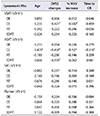2. Xiang B, Biji S, Liu JX, Chu WC, Yeung DK, Yeung CK. Functional brainstem changes in response to bladder function alteration elicited by surgical reduction in bladder capacity: a functional magnetic resonance imaging study. J Urol. 2010; 184:2186–2191.


3. Yeung CK, Diao M, Sreedhar B. Cortical arousal in children with severe enuresis. N Engl J Med. 2008; 358:2414–2415.


4. Nevéus T. Pathogenesis of enuresis: towards a new understanding. Int J Urol. 2017; 24:174–182.


5. Ornitz EM, Russell AT, Hanna GL, Gabikian P, Gehricke JG, Song D, et al. Prepulse inhibition of startle and the neurobiology of primary nocturnal enuresis. Biol Psychiatry. 1999; 45:1455–1466.


6. Von Gontard A, Schmelzer D, Seifen S, Pukrop R. Central nervous system involvement in nocturnal enuresis: evidence of general neuromotor delay and specific brainstem dysfunction. J Urol. 2001; 166:2448–2451.


8. von Gontard A, Equit M. Comorbidity of ADHD and incontinence in children. Eur Child Adolesc Psychiatry. 2015; 24:127–140.


9. Eggert P, Freischmidt S, Bismarck PV, Schulz-Jürgensen S. Differentiation of subgroups of monosymptomatic enuresis according to prepulse inhibition of the startle reflex. Acta Paediatr. 2012; 101:e304–e308.

10. Hawk LW Jr, Yartz AR, Pelham WE Jr, Lock TM. The effects of methylphenidate on prepulse inhibition during attended and ignored prestimuli among boys with attention-deficit hyperactivity disorder. Psychopharmacology (Berl). 2003; 165:118–127.


11. Lei D, Ma J, Du X, Shen G, Tian M, Li G. Altered brain activation during response inhibition in children with primary nocturnal enuresis: an fMRI study. Hum Brain Mapp. 2012; 33:2913–2919.


12. Golding J, Pembrey M, Jones R. ALSPAC Study Team. ALSPAC--the Avon Longitudinal Study of Parents and Children. I. Study methodology. Paediatr Perinat Epidemiol. 2001; 15:74–87.

13. von Gontard A, Moritz AM, Thome-Granz S, Freitag C. Association of attention deficit and elimination disorders at school entry: a population based study. J Urol. 2011; 186:2027–2032.


14. Butler R, Heron J. Alspac Study Team. Exploring the differences between mono- and polysymptomatic nocturnal enuresis. Scand J Urol Nephrol. 2006; 40:313–319.


15. Kuhn S, Natale N, Siemer S, Stoeckle M, von Gontard A. Clinical differences in daytime wetting subtypes: urge incontinence and postponed voiding. J Urol. 2009; 182:4 Suppl. 1967–1972.


16. Zink S, Freitag CM, von Gontard A. Behavioral comorbidity differs in subtypes of enuresis and urinary incontinence. J Urol. 2008; 179:295–298. discussion 8.

17. Giramonti KM, Kogan BA, Halpern LF. The effects of anticholinergic drugs on attention span and short-term memory skills in children. Neurourol Urodyn. 2008; 27:315–318.


18. Kay G, Crook T, Rekeda L, Lima R, Ebinger U, Arguinzoniz M, et al. Differential effects of the antimuscarinic agents darifenacin and oxybutynin ER on memory in older subjects. Eur Urol. 2006; 50:317–326.


19. Sommer BR, O'Hara R, Askari N, Kraemer HC, Kennedy WA 2nd. The effect of oxybutynin treatment on cognition in children with diurnal incontinence. J Urol. 2005; 173:2125–2127.


20. Kim SJ, Lee YJ, Cho SJ, Cho IH, Lim W, Lim W. Relationship between weekend catch-up sleep and poor performance on attention tasks in Korean adolescents. Arch Pediatr Adolesc Med. 2011; 165:806–812.


21. Kim SJ, Lee YJ, Jang JH, Lim W, Cho IH, Cho SJ. The relationship between psychotic-like experiences and attention deficits in adolescents. J Psychiatr Res. 2012; 46:1354–1358.


22. Elia J, Takeda T, Deberardinis R, Burke J, Accardo J, Ambrosini PJ, et al. Nocturnal enuresis: a suggestive endophenotype marker for a subgroup of inattentive attention-deficit/hyperactivity disorder. J Pediatr. 2009; 155:239–244.e5.


23. Yang TK, Huang KH, Chen SC, Chang HC, Yang HJ, Guo YJ. Correlation between clinical manifestations of nocturnal enuresis and attentional performance in children with attention deficit hyperactivity disorder (ADHD). J Formos Med Assoc. 2013; 112:41–47.


24. Van Herzeele C, Dhondt K, Roels SP, Raes A, Groen LA, Hoebeke P, et al. Periodic limb movements during sleep are associated with a lower quality of life in children with monosymptomatic nocturnal enuresis. Eur J Pediatr. 2015; 174:897–902.


25. Van Herzeele C, Dhondt K, Roels SP, Raes A, Groen LA, Hoebeke P, et al. Neuropsychological functioning related to specific characteristics of nocturnal enuresis. J Pediatr Urol. 2015; 11:208.e1–208.e6.

26. Fonseca EG, Bordallo AP, Garcia PK, Munhoz C, Silva CP. Lower urinary tract symptoms in enuretic and nonenuretic children. J Urol. 2009; 182:4 Suppl. 1978–1983.


27. Rittig N, Hagstroem S, Mahler B, Kamperis K, Siggaard C, Mikkelsen MM, et al. Outcome of a standardized approach to childhood urinary symptoms-long-term follow-up of 720 patients. Neurourol Urodyn. 2014; 33:475–481.


28. Hochman EY, Vaidya AR, Fellows LK. Evidence for a role for the dorsal anterior cingulate cortex in disengaging from an incorrect action. PLoS One. 2014; 9:e101126.

30. Newgreen D, Bosman B, Hollestein-Havelaar A, Dahler E, Besuyen R, Sawyer W, et al. Solifenacin in children and adolescents with overactive bladder: results of a phase 3 randomised clinical trial. Eur Urol. 2017; 71:483–490.










 PDF
PDF Citation
Citation Print
Print




 XML Download
XML Download